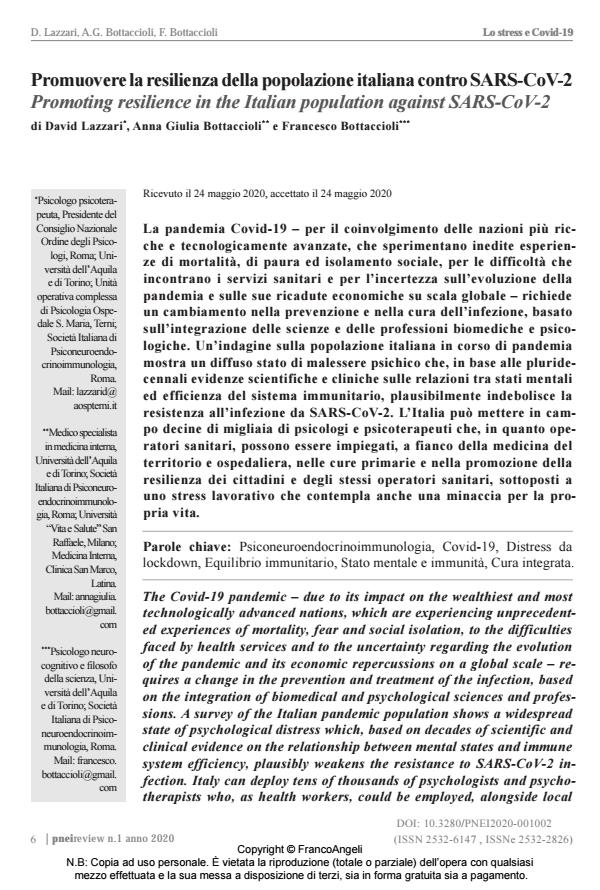Promuovere la resilienza della popolazione italiana contro SARS-CoV-2
Titolo Rivista PNEI REVIEW
Autori/Curatori David Lazzari, Anna Giulia Bottaccioli, Francesco Bottaccioli
Anno di pubblicazione 2020 Fascicolo 2020/1
Lingua Italiano Numero pagine 20 P. 6-25 Dimensione file 484 KB
DOI 10.3280/PNEI2020-001002
Il DOI è il codice a barre della proprietà intellettuale: per saperne di più
clicca qui
Qui sotto puoi vedere in anteprima la prima pagina di questo articolo.
Se questo articolo ti interessa, lo puoi acquistare (e scaricare in formato pdf) seguendo le facili indicazioni per acquistare il download credit. Acquista Download Credits per scaricare questo Articolo in formato PDF

FrancoAngeli è membro della Publishers International Linking Association, Inc (PILA)associazione indipendente e non profit per facilitare (attraverso i servizi tecnologici implementati da CrossRef.org) l’accesso degli studiosi ai contenuti digitali nelle pubblicazioni professionali e scientifiche
La pandemia Covid-19 - per il coinvolgimento delle nazioni più ricche e tecnologicamente avanzate, che sperimentano inedite esperienze di mortalità, di paura ed isolamento sociale, per le difficoltà che incontrano i servizi sanitari e per l’incertezza sull’evoluzione della pandemia e sulle sue ricadute economiche su scala globale - richiede un cambiamento nella prevenzione e nella cura dell’infezione, basato sull’integrazione delle scienze e delle professioni biomediche e psicologiche. Un’indagine sulla popolazione italiana in corso di pandemia mostra un diffuso stato di malessere psichico che, in base alle pluridecennali evidenze scientifiche e cliniche sulle relazioni tra stati mentali ed efficienza del sistema immunitario, plausibilmente indebolisce la resistenza all’infezione da SARS-CoV-2. L’Italia può mettere in campo decine di migliaia di psicologi e psicoterapeuti che, in quanto operatori sanitari, possono essere impiegati, a fianco della medicina del territorio e ospedaliera, nelle cure primarie e nella promozione della resilienza dei cittadini e degli stessi operatori sanitari, sottoposti a uno stress lavorativo che contempla anche una minaccia per la propria vita.
Parole chiave:Psiconeuroendocrinoimmunologia, Covid-19, Distress da lockdown, Equilibrio immunitario, Stato mentale e immunità, Cura integrata.
David Lazzari, Anna Giulia Bottaccioli, Francesco Bottaccioli, Promuovere la resilienza della popolazione italiana contro SARS-CoV-2 in "PNEI REVIEW" 1/2020, pp 6-25, DOI: 10.3280/PNEI2020-001002